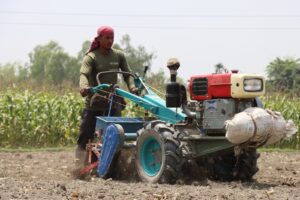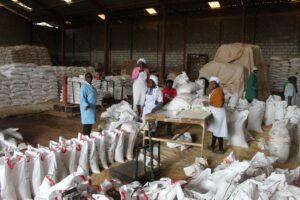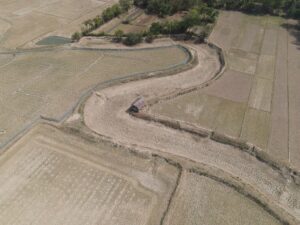The orientation of producing more food, associated with fertilizer overuse, particularly nitrogen (N), has caused a deterioration in soil physical, chemical, and microbiological properties and functions and increased soil and water pollution. With increasing pressure to meet global food demand while fostering environmental sustainability, a paradigm shift is needed to a more judicious use of N fertilizer.
Optimal nutrient management in rice is important for food security, climate change mitigation, adaptation and transformation, and attainment of several sustainable development goals. Fertilizer use has reduced agriculture expansion into natural ecosystems by increasing crop productivity on existing land. However, while yields increased with fertilizer use in the 1960s, they stagnated in intensive rice systems in the mid- 1980s despite the development of varieties with greater yield potential. This resulted in large yield gaps.
This was largely due to excessive or imbalanced fertilizer use based on increased reliance on blanket fertilizer application, coupled with a rapid decline in the efficiency of fertilizer uptake by plants, indicating that increased fertilizer use outpaced yield improvements. The orientation of producing more food, associated with fertilizer overuse, particularly nitrogen (N), has caused a deterioration in soil physical, chemical, and microbiological properties and functions and increased soil and water pollution. With increasing pressure to meet global food demand while fostering environmental sustainability, a paradigm shift is needed to a more judicious use of N fertilizer.
About 50% of global N fertilizer is applied to major cereals: Zea mays (maize; 17%), Triticum aestivum (wheat; 18%), and Oryza sativa (rice; 16%) . However, globally, N use efficiency, a measure of the short-term balance between N used for grain production and N lost to the environment, has remained below 40%, indicating that more than 60% of applied N remains unused or is lost from soil. Increasing N use efficiency in rice agri-food systems becomes all the more important, given that the commodity is a staple food for more than half the global population.
More than 90% of the rice is produced in Asia, mostly by smallholder farmers. Due to high subsidy on urea fertilizer, farmers tend to apply large quantities of N fertilizer in excess of plant requirements . However, grain yield response diminishes as N fertilizer rate increases and may cause lodging and susceptibility to pest and disease damage when overapplied.
Excess reactive N has detrimental effects in agroecosystems, such as nitrous oxide emissions, increased soil acidity, decreased biodiversity, and groundwater contamination . In rice production, farmers apply large amounts of N fertilizer to maximize yield, but only 20–50% of N is taken up by the crop. This is largely due to farmers applying large quantities of N fertilizer at early growth stages when the rice plants have not fully developed the root system. The resulting loss of the appliedN, which is amobile nutrient leads to increased water and land pollution and greenhouse gas (GHG) emissions.
There is a need for tailored solutions that are sustainable andmeet the increasing global demand for food, feed, and energy while protecting the environment. Rice production also needs to be profitable for farmers; this can be partly achieved by farmers applying appropriate types and amounts of fertilizers. Fertilizers typically constitute 20% of the input costs in rice production and achieving efficient fertilizer management is challenging in smallholder farming systems where soils and cropmanagement can vary even within short distances.
Site-specific nutrient management (SSNM) enable farmers to apply adequate and appropriate amounts of nutrients to suit soil, crop variety, and climate, hence mitigating the potential trade-offs between productivity and environmental health.
Our mini-review clearly shows that SSNM in rice cropping systems increases rice yield, profit, and N use efficiency while reducing N losses and GHG emissions when compared with the farmer practice. The superior performance of SSNM compared to the farmer practice is mainly due to better distribution with more splits ofNfertilizer during the growing season coupled with balanced fertilization.
However, SSNM has mainly focused on the major nutrients, ignoring micronutrients, and thus, impacting human nutrition for those whose diets are rice-based, while potentially mining the soils of the micronutrients. SSNM-based digital decision support tools enable dissemination of SSNM recommendations at scale, but this requires a pluralistic approach that fosters collaboration among multiple organizations and service providers with support from governments.
Additionally, linking the digital tools with GIS and remote sensing tools allows fine-tuning of SSNM recommendations, addressing the huge spatial variability in smallholder farming systems. SSNM research and evaluation has focused on favorable environments in Asia, despite the increasing demand and production in Africa.
More research is needed on SSNM under diverse management practices, such as direct seeding, and in marginal environments along with quantification of nutrient losses, along with inter-disciplinary approaches to enhance farmer uptake of SSNM.
Read the study:
Chivenge P, Sharma S, Bunquin MA, Hellin J (2021) Improving Nitrogen Use Efficiency—A Key for Sustainable Rice Production Systems. Frontiers in Sustainable Food Systems Vol. 5.






